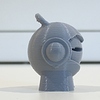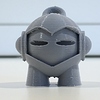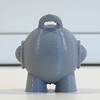I just printed my first Marvin and to be honest I am not pleased at all. Would anyone mind to drop some suggestions? It is printed on an Ultimaker 2+.
Simplify3D Settings below.
Thank You guys! 
; G-Code generated by Simplify3D® Version 3.1.0
; Mar 15, 2017 at 9:57:02 AM
; Settings Summary
; processName,Process 1
; applyToModels,Marvin_2.5cm
; profileName,PLA
; profileVersion,2016-12-24 12:14:16
; baseProfile,Ultimaker 2 Extended
; printMaterial,PLA
; printQuality,High
; printExtruders,
; extruderName,Primary Extruder
; extruderToolheadNumber,0
; extruderDiameter,0.4
; extruderAutoWidth,1
; extruderWidth,0.48
; extrusionMultiplier,1
; extruderUseRetract,1
; extruderRetractionDistance,4
; extruderExtraRestartDistance,0
; extruderRetractionZLift,0
; extruderRetractionSpeed,2000
; extruderUseCoasting,1
; extruderCoastingDistance,1
; extruderUseWipe,1
; extruderWipeDistance,4
; primaryExtruder,0
; layerHeight,0.1
; topSolidLayers,4
; bottomSolidLayers,4
; perimeterOutlines,2
; printPerimetersInsideOut,1
; startPointOption,1
; startPointOriginX,0
; startPointOriginY,0
; startPointOriginZ,300
; sequentialIslands,0
; spiralVaseMode,0
; firstLayerHeightPercentage,150
; firstLayerWidthPercentage,140
; firstLayerUnderspeed,0.2
; useRaft,0
; useSkirt,0
; usePrimePillar,0
; useOozeShield,0
; infillExtruder,0
; internalInfillPattern,Fast Honeycomb
; externalInfillPattern,Rectilinear
; infillPercentage,25
; outlineOverlapPercentage,35
; infillExtrusionWidthPercentage,125
; minInfillLength,3
; infillLayerInterval,1
; infillAngles,0
; overlapInfillAngles,0
; generateSupport,0
; temperatureName,Primary Extruder,Heated Build Platform
; temperatureNumber,0,1
; temperatureSetpointCount,1,1
; temperatureSetpointLayers,1,1
; temperatureSetpointTemperatures,220,50
; temperatureStabilizeAtStartup,1,1
; temperatureHeatedBed,0,1
; temperatureRelayBetweenLayers,0,0
; temperatureRelayBetweenLoops,0,0
; fanLayers,1,2
; fanSpeeds,0,100
; blipFanToFullPower,1
; adjustSpeedForCooling,1
; minSpeedLayerTime,15
; minCoolingSpeedSlowdown,10
; increaseFanForCooling,1
; minFanLayerTime,15
; maxCoolingFanSpeed,100
; increaseFanForBridging,1
; bridgingFanSpeed,50
created
Mar '17last reply
Mar '17- 28
replies
- 3.1k
views
- 21
users
- 5
likes



